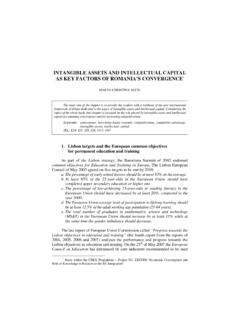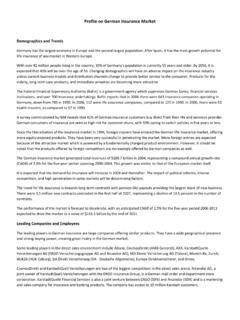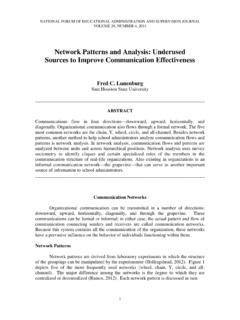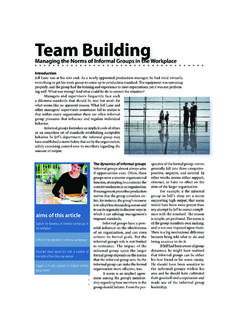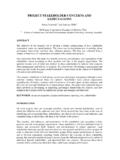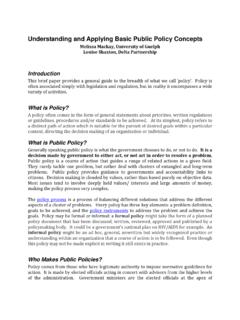Transcription of Continuous Improvement British Columbia …
1 The Learning OrganizationAn to the Learning organization organization Thought of Learning to Become a Learning and Learning organization Characteristics ChecklistBackground to the Learning OrganizationThe Learning OrganizationLearning Organizations are people-focused. They promote process, progress and sustainability through: Increased job satisfaction Team-based environments Autonomy, and Learning at all levelsThe Learning organization LOshave the following characteristics: Provide learning opportunities & use learning to reach their goals Link individual with organizational performance Make it safe for people to share openly and take risks Embrace creative tension as a source of energy and renewal Are continuously aware of and interact with their environmentCalvert et al.
2 1994; Watkins and Marsick1993A Learning organization .. An organization that facilitates the learning of all its members and continually transforms itself M. Pedler .. Characterized by continual Improvement through new ideas, knowledge and Public Service of CanadaThe Learning organization The Learning organization concept emerged in the late 90s to address the impacts of accelerated changeThe Learning organization These changes were driven by a variety of factors including: a shift from the Industrial Ageto the Information Age Impacts ofProductivity Improvements, and Generational factors influencing the workplaceThe Learning organization The world is in the midst of an unprecedented transformation from an industrial-based economy and society to a knowledge-based economy and society.
3 A Policy for Continuous Learning in the Public Service of CanadaThe Learning OrganizationAs a "Organizations must develop a capacity for fast-paced learn to love change Tom PetersJobsIndustrial Age: High-discretion Requires considerable thinking & decision making Emphasizes giving employees authorityto make decisionsInformation Age: Low-discretion Required little decision making Analyzed and broken into simple tasks requiring very little thinking on the part of B. Hill, PhDEmployeesIndustrial Age: Ability to network, people focus Use initiative, flexible Think outside the box Ability to multi-task, shift gears, meet shifting demands of the workplace People with visionand attitude.
4 Information Age:Excerpted and adapted from 21st Century Discipline,by Jane Bluestein, 1999 Ability to fit in Follow orders, chain of command Think inside the box Perform as directed Tasks/assignments do not vary much in one job description The Learning OrganizationThe information age has resulted in significant productivity improvementsThe Learning organization The US Dept of Commerce estimated that Quality Systems and processes (TQM) implemented in American companies during the 1970's and 1980's contributed to half of the productivity gain of that period. Dr. Jose LlanesThe Learning OrganizationHowever, one by product of increased productivity is high job-stress levelsThe Learning organization Increased Stress One in 10 adults worldwide suffer stress, depression and burnout The ILO predicts a dramatic increase in stressas even faster technologies are introduced and globalisationaccelerates In the UK, three in 10 employees suffer mental problemseach year from stress-related behaviour Stress-related illness and absenteeism costs the [UK]
5 Economy the equivalent of 10% of its GDPJ eremy Rifkin, The End of WorkThe Learning organization Serious Mental Health Issues Depression rates that have doubledand anger rates that have increased by 900 %in the past three years in gov t workplaces The pressure on managers to manage change, and on workers to cope effectively with it, is intense Warren ShepellResearch Group, July 12th2004 Learning organization Karoshi: Death from Overwork Japanese managers often work for 10-12 hours a day 6 -7 days a week, year after year leading to a phenomenon known as KAROSHI Death from Overwork It was estimated in 1990 that over 10,000 peoplewere dying each year from KAROSHI in JapanAsia Pacific Management Learning OrganizationGenerational factors are also impacting information age workplaces The Learning organization Generation Gap Public sector workplaces will continue to be challenged to attract, recruit and the Nexus generation of 18-to 35-year-olds.
6 Who value non-wage factors such as career growthand work-lifebalance when choosing an employer Warren ShepellResearch Group, July 12th2004 Learning organization "The challenge for leaders in the twenty-first century will be how to release the brainpower of their organizations" (Bennis, 1997)Learning organization Thought LeadersDavid GarvinPeter SengeDavid Garvin Continuous Improvement requires a commitment to learning David Garvin Professor of Business Administration at the Harvard Business School: Taught in executive education programs and consulted for over fifty organizations He is the author or co-author of nine books and more than twenty-five articles Three-time winner of the McKinsey Award, and a winner of the Beckhard Prize and the Smith-Weld PrizeDavid GarvinGarvin believes that a Learning Achieves Continuous Improvement through organizational learning Transfers knowledge and modifies its behaviour to reflect it, and As a wholemust learn in order to manage change and ensure sustainabilityNotable Publications Learning in Action.
7 A Guide to Putting the Learning organization to Work (2003) Building a Learning organization (2004)David GarvinAccording to Garvin, Learning Organizations areskilled at 5 main learning activities: problem with new from past from the best practices of knowledge quickly and efficiently throughout the organizationPeter Senge People don t resist change, they resist being changed! Peter Senge Senior Lecturer at the Massachusetts Institute of Technology Best known for his book,The Fifth Discipline: The Art and Practice of The Learning organization (1990) Named a Strategist of the Century by the Journal of Business Strategy, one of 24 men and women who have had the greatest impact on the way we conduct business today (1999)Peter SengeSenge believes that a Learning Decentralizes the role of leadership Places human values at the cornerstone of the workplace Recognizes vision, purpose, reflectivenessand systems thinkingas essentialNotable Publications The Fifth Discipline: The Art and Practice of The Learning organization (1990) The Dance of Change.
8 The Challenges to Sustaining Momentum in Learning Organizations (1999)Peter SengeAccording to Senge a Learning Decentralizes the role of leadershipto increase the contribution of all employees Employs a holistic approachand gets everyone on the same page Employs systems and structuresfor sustainability Puts a strong emphasis on informal and social networks Is skilled in the area of five key disciplines described in his book, The Fifth Disciplines #1 Personal Mastery Personal mastery is the discipline of continually clarifying and deepening our personal vision, of focusing our energies, of developing patience.
9 And of seeing reality objectively (Senge 1990: 139) Five Disciplines #2 Mental Models The deeply ingrained assumptions, generalizations, and even pictures or images that influence how we understand the worldFive Disciplines #3 Shared Vision The "picture of the future." Intuitive and instinctive Not something that's learned by rote A collective experience--it's the cumulative total of each participant's personal visionFive Disciplines #4 Team Learning Any group's collective IQ will always be much higher than an individual's IQ The only way to begin building group IQ is to open the channels of communication within the group and start talking to one anotherFive Disciplines #5 Systems Thinking We must look at the patterns that connect the larger system Systems thinkers cure headaches by removing the cause.
10 Rather than simply ingesting aspirin Systems thinkers believe that by examining these patterns of interplay, we can better pinpoint the important issues. Five Disciplines Benefits of Adopting the 5 Disciplines: Less use of defensive routines in work and more proactivity Greater trust, faster change, more effective communication flows Group self-awareness, collective learning & greater cohesiveness & creativityExamples of Learning OrganizationsExamples of Learning OrganizationsPublic Sector Public Service of Canada Alberta Public ServicePrivate Sector General Electric (GE) Johnsonville Foods AT & T McDonnell Douglas The Burton GroupPublic Service of CanadaExamples of Learning OrganizationsThe Public service of Canada introduced a Continuous Learning Policy in 2002 O

